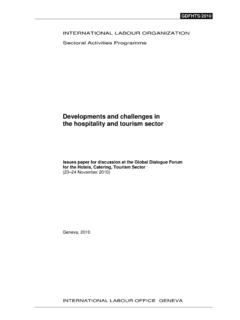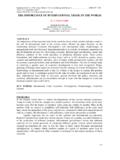Transcription of The Impacts of Globalisation - oecd.org
1 Global Forum on Transport and Environment in a Globalising World 10-12 November 2008, Guadalajara, Mexico The Impacts of Globalisation on International Air Transport Activity Past trends and future perspectives Ken Button, School of George Mason University, USA 2 NOTE FROM THE SECRETARIAT This paper was prepared by Prof. Ken Button of School of George Mason University, USA, as a contribution to the OECD/ITF Global Forum on Transport and Environment in a Globalising World that will be held 10-12 November 2008 in Guadalajara, Mexico.
2 The paper discusses the Impacts of increased Globalisation on international air traffic activity past trends and future perspectives. 3 TABLE OF CONTENTS NOTE FROM THE SECRETARIAT .. 2 THE IMPACT OF globalization ON INTERNATIONAL AIR TRANSPORT ACTIVITY - PAST TRENDS AND FUTURE PERSPECTIVE .. 5 1. Introduction .. 5 2. globalization and internationalization .. 5 3. The Basic Features of International Air Transportation .. 6 Historical perspective .. 6 The modern industry .. 8 4. The effect of globalization on airline markets.
3 9 5. Implications of global air transport institutional changes in airline regulation .. 11 Fares .. 11 Linkages between domestic and international air services .. 14 Airline profits .. 16 6. The Shifting Situation .. 24 The traffic forecasts that we have .. 24 Globalized labor markets, migration and international air transport .. 25 The business models of airlines .. 31 Changing industrial needs .. 33 Developments in emerging markets .. 34 7. Conclusions .. 37 REFERENCES .. 38 Tables Table 1.
4 The ten largest international airlines by scheduled passenger-kilometres .. 9 Table 2. The 20 largest international airports by passengers .. 9 Table 3. European low cost carriers that ceased to exist (2003 to 2005).. 21 Table 4. Strategic Airline 22 Table 5. Scheduled freight tonne-kilometres 34 Table 6. Selected indices of China's Civil Air Transport System .. 35 Figures Figure 1. Trends in World international trade, and airlines revenue passenger kilometres .. 10 Figure 2. Short-term links between World-trade in manufactures and air freight volumes.
5 11 Figure 3. The simple economics of Open Skies policies .. 12 Figure 4. The implications of globalization on the various air transport markets .. 14 4 Figure 5. A dog-bone or dumb-bell international air transport network .. 15 Figure 6. Operating margins of airlines .. 17 Figure 7. Airline profitability by global region .. 18 Figure 8. The alternative views of the implications of migration .. 27 Figure 9. The notion of 28 Figure 10. Impacts of opening more gateways on air transport networks and flows.
6 29 Figure 11. Air travel between the UK and selected transition economies .. 31 Figure 12. Throughput of freight at major Chinese cargo hub airports .. 36 5 THE IMPACT OF globalization ON INTERNATIONAL AIR TRANSPORT ACTIVITY - PAST TRENDS AND FUTURE PERSPECTIVE 1. Introduction 1. Air transportation is a major industry in its own right and it also provides important inputs into wider economic, political, and social processes. The demand for its services, as with most transport, is a derived one that is driven by the needs and desires to attain some other, final objective.
7 Air transport can facilitate, for example, in the economic development of a region or of a particular industry such as tourism, but there has to be a latent demand for the goods and services offered by a region or by an industry. Lack of air transport, as with any other input into the economic system, can stymie efficient growth, but equally inappropriateness or excesses in supply are wasteful. 2. Economies, and the interactions between them, are in a continual state of flux, and although economists notions of equilibrium have some very useful intellectual content, and also validity in the very short-run, in reality the world is dynamic.
8 This dynamism, of which the particular thrust of globalization is the concern here, has implications for industries such as air transport that service it. But there are also feedback loops, because, developments in air transport can shape the form and the speed at which globalization and related processes take place. In effect, while the demand for air transport is a derived, the institutional context in which air transport services are delivered have knock-on effects on the economic system.
9 These feedback loops may entail direct economic, political, and social effects that, for example, accompany enhanced trade and personal mobility, but they may also be indirect, as for example through the Impacts of air transport on the environment. 3. The analysis here is, by necessity, excessively simplistic given the multi-dimensional and dynamic nature of globalization , and focuses on one small sector, international commercial aviation, and on only one direction of causality, the implications of globalization for this sector.
10 Some related considerations are embraced where particularly important. For example, there is an increasing blurring of international and domestic air transport as airlines form alliances and invest in each other to form global networks; indeed, the domestic and international air transport market within the European Union (EU) is de facto one market. Also, not all feedback loops are ignored, particularly when changes in air transport facilitate global trends that then, in turn, feed back on the air transport industries; migration of labor is one example of this.

















